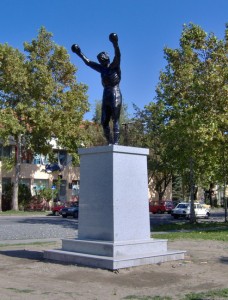“When they’re cheering for Rocky, they’re cheering for themselves” – Sylvester Stallone
Many movie buffs and locals to the city of Philadelphia would argue that Rocky is one of the most influential and inspiring fictional icons in the history of American media. He is an average, middle class white American who is given an impossible task. He takes it on without fear to show that he is not just an average joe because of where he comes from. He is a symbol for masculinity, self-respect, and and drive that all people in his place can look up to. In his piece Reaffirming Tradition Values, Daniel J Leab explains that the reason Rocky got as much praise and appreciation as it did is because it mimicked the mood and the important aspects of 1970’s America. As written by Leab, “the film touched “a live nerve with the public,” as Frank Rich put it. American audiences, influenced by the bicentennial’s strong emphasis on the validity of the American Dream, had lost interest in downbeat themes, in bleak reality, in attacks on old-fashioned values- all subjects which as films of one sort or another had recently done well at the box office” (Leab, 269). Rocky showed middle class America that they can put up a fight against bigger powers and make a name for themselves no matter their background. This is what 1970’s America needed, to see that there is hope for those in a similar position, who until then felt hopeless.

However, does Rocky really deserve the icon status he has gained? I understand that I was not alive during that time and I may not understand the struggle or feel the connection that so many American’s had to him. However, its my outside, modern perspective that will allow me to make the unbiased critiques. First of all, its frustrating to me that the embodiment of the 1970’s American dream has to be a fighter. I understand its symbolic, I understand that if you get knocked down you have to get back up, but I would never idolize someone who could make 150,000 dollars for knocking someone out. I don’t think for a second that that is a realistic standard for the American dream. He did not even really do much to earn the opportunity to win that money. Someone found him and picked a fight with him. That’s not working to achieve a goal, that’s being handed an opportunity and working not to waste it. Not all Americans are going to be put in that situation.

However, I do see that his story is one that was heavily connected to what people were feeling at the time, and that’s something I will probably never be able to fully understand. However, I think my main frustration and the cause for my ranting is that I think a majority of the people who idolize him in present times may not be critically analyzing the film. In fact, I was one of those people before I actually watched it. In addition to my realization about his false American dream image, the racist and sexist under-themes are frustrating and make it hard for me to see him the same way. I think this is why he has maintained his iconic status even beyond the time period where he was most relevant. People don’t watch the film with the intention to critique, hence he stays relevant because he is a tough guy who beats his odds. Since this kind of character is much more popular in modern times, I am rejecting it. I say no more to the strong, violent male character who does more than he thinks he can. Where my girls at?
Works Cited
Leab, Daniel J. “Reaffirming Traditional Values The Blue Collar Ethnic in Bicentennial America: Rocky.” Hollywood’s America: Twentieth-Century America Through Film. Ed. Steven Mintz and Randy Roberts. N.p.: Wiley-Blackwell, 2010. 264-71. Print.
The first picture : https://en.wikipedia.org/wiki/Rocky_Balboa
The second picture: http://totalrocky.com/the-films/rocky-iii-1982/photo-gallery
